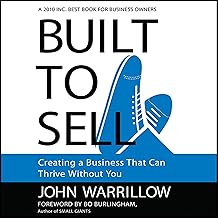
How to Fail at Almost Everything and Still Win Big: Kind of the Story of My Life
Scott Adams
4.7 on Amazon
21 HN comments

The Power of Full Engagement: Managing Energy, Not Time, Is the Key to High Performance and Personal Renewal
Jim Loehr and Tony Schwartz
4.6 on Amazon
21 HN comments

An Elegant Puzzle: Systems of Engineering Management
Will Larson
4.5 on Amazon
19 HN comments

The Fifth Risk: Undoing Democracy
Michael Lewis
4.5 on Amazon
19 HN comments

Purple Cow: Transform Your Business by Being Remarkable
Seth Godin
4.5 on Amazon
16 HN comments

Team of Teams: New Rules of Engagement for a Complex World
Stanley Gen. McChrystal, Tantum Collins , et al.
4.7 on Amazon
16 HN comments

Inspired: How to Create Tech Products Customers Love (Silicon Valley Product Group)
Marty Cagan
4.6 on Amazon
15 HN comments

Playing to Win: How Strategy Really Works
A.G. Lafley and Roger L. Martin
4.5 on Amazon
15 HN comments

Good Strategy/Bad Strategy: The difference and why it matters
Richard Rumelt
4.6 on Amazon
15 HN comments

Built to Sell: Creating a Business That Can Thrive Without You
John Warrillow, Erik Synnestvedt, et al.
4.7 on Amazon
14 HN comments

American Kingpin: The Epic Hunt for the Criminal Mastermind Behind the Silk Road
Nick Bilton, Will Damron, et al.
4.7 on Amazon
13 HN comments

Pitch Anything: An Innovative Method for Presenting, Persuading, and Winning the Deal
Oren Klaff
4.6 on Amazon
13 HN comments

Lean In: Women, Work, and the Will to Lead
Sheryl Sandberg
4.5 on Amazon
12 HN comments

Who
Geoff Smart and Randy Street
4.5 on Amazon
11 HN comments

Six Thinking Hats
Edward de Bono
4.6 on Amazon
11 HN comments
steveeq1onJuly 2, 2010
ckluisonJune 24, 2014
Six Thinking Hats - best way to think like an analyst (and to lead meetings that are effective)
Both of these are killer and quick and easy books.
rman666onJuly 2, 2010
avtharonAug 17, 2021
NiceWayToDoITonJan 18, 2021
1. If I remember correctly, one of Thinking Techniques I read long time ago (not sure Edward de Bono) is to create distinctive quorum of distinctive characters you look up to, each having a different hat (book "Six Thinking Hats"). So when we think about problem, we should talk with each person to get its view.
2. Improving Chess ability can be done by playing on both sides.
3. In the movie "A Beautiful Mind" mathematician John Nash had vivid hallucinations indistinguishable from reality. (edit: it looks like rogue "tulpa")
4. Nikola Tesla had ability to imagine any object so intensively on demand they would float like a hologram, with eyes wide open.
What is amazing is that brain can do so much, and our knowledge about its abilities is so small. It would be nice if we knew techniques how to wake up some parts of the brain on demand, the same way one would learning hot to read or write.
steveeq1onNov 26, 2011
1) Lateral Thinking: http://tinyurl.com/88ugdjz
2) Six Thinking Hats: http://tinyurl.com/7t2w27y . There is a video course available on youtube as well: http://tinyurl.com/6q4rz2t
I learned about them through Alan Kaye's reading list: http://tinyurl.com/83bqlbx He has a section on learning and creativity that has some other good alternatives.
steveeq1onMay 30, 2016
Lateral Thinking: https://www.youtube.com/watch?v=jFFZ0XSfCRw
Six Thinking Hats: https://www.youtube.com/watch?v=3Mtc_CBTIeI
keithnzonMar 6, 2017
Various books by Tony Buzan ( memory, speed reading, mind mapping ) and six thinking hats (and others) by edward de bono really got me to see our minds are very versatile and, like our bodies, can be pushed in prodded to do lots of things
Puzzling through many philosophy books has probably given me some my more dramatic changes in the way I see the world. But not one in specific, each provided little "ah hah!"s
All of Calvin and Hobbes
The art of war,book of 5 rings, and the prince, all made it clear that strategy and winning are quite different from the sanitized western middle class life I was brought up in.
zer0thonFeb 3, 2018
However, I worried that most people would not have the time/patience to really get involved with a problem. Furthermore, the process might be to cumbersome and rational for real world problems.
cJ0thonMay 31, 2016
That said I probably read the book at the right time because it works best when you have a certain naivete and faith that you stumbled upon the ultimate silver bullet for problem solving.
Had I encountered the book just yet I'd probably have been more dismissive of it. "Oh yeah, here we go .. another guy who wants to sell you some self-help fluff disguised in a business context"
nyokodoonAug 17, 2021
The biggest impact life lesson I had from that book was to be upfront with my feelings (red hat.) Unacknowledged emotions sit in the background and strongly influence thinking while often being quite dumb. Emotions brought out in the open tend to shrink to their proper significance and can be quite informative.